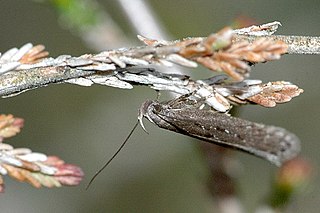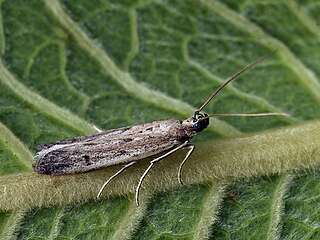
Apamea remissa, the dusky brocade, is a species of moth of the family Noctuidae. It is distributed throughout Europe and Turkey, ranging across the Palearctic realm to Siberia, Manchuria and Japan. It has also been reported from Alaska.

Thera variata, the spruce carpet, is a moth of the family Geometridae. It is found throughout Europe, North Asia and Japan. The common name spruce carpet is also used when referring to Thera britannica.

Acrobasis consociella is a moth of the family Pyralidae. It is found in Europe.

Aglossa pinguinalis, the large tabby or grease moth, is a moth in the subfamily Pyralinae. The species was first described by Carl Linnaeus in his 1758 10th edition of Systema Naturae. The dark-hued larvae feed on animal fats,

Ephestia elutella, the cacao moth, tobacco moth or warehouse moth, is a small moth of the family Pyralidae. It is probably native to Europe, but has been transported widely, even to Australia. A subspecies is E. e. pterogrisella.

Heliothis viriplaca, the marbled clover, is a moth of the family Noctuoidea. It is found in Europe and across the Palearctic to Central Asia then to Japan, Korea and Sakhalin. In the south, it penetrates to Kashmir and Myanmar. As a migratory moth, it also reaches areas in northern Fennoscandia in some years. North of the Alps, both indigenous and immigrant individuals occur in certain areas. The heat-loving species occurs mainly on dry grasslands, fallow land, heathlands and sunny slopes and slopes and the edges of sand and gravel pits.

Swammerdamia pyrella is a moth of the family Yponomeutidae. It is found in Europe, North America and Japan.

Evergestis extimalis is a species of moth of the family Crambidae. It is found in the Palearctic.

Cataclysta lemnata, the small china-mark, is a moth species of the family Crambidae. It is found in Europe, Morocco and Iran.

Parapoynx stratiotata, the ringed china-mark, is a moth of the family Crambidae. The species was first described by Carl Linnaeus in his 1758 10th edition of Systema Naturae. It is found in Europe where the distribution area extends in the north to the British Isles including Ireland and in the south to Sardinia, Sicily and Greece. The species is also found across the Palearctic in North Africa, Lebanon, Turkey, Azerbaijan, Kyrgyzstan, Uzbekistan and China..

Anania lancealis is a species of moth of the family Crambidae, described by the Austrian lepidopterists Michael Denis and Ignaz Schiffermüller in 1775. The moth is found in Asia and Europe.

Anania stachydalis is a species of moth of the family Crambidae. It is found in Europe. The species closely resembles Anania coronata.

Falcaria lacertinaria, the scalloped hook-tip, is a moth of the family Drepanidae. The species was first described by Carl Linnaeus in his 1758 10th edition of Systema Naturae It is found in Europe and Anatolia then east to Eastern Siberia.

Tetheella is a monotypic moth genus in the family Drepanidae described by Werny in 1966. Its single species, Tetheella fluctuosa, the satin lutestring, was described by Jacob Hübner in 1803. It is found from western Europe across the Palearctic to Kamchatka, Sakhalin Island, Korea and Japan.

Neofaculta ericetella is a moth of the family Gelechiidae. It is found in Europe and Asia Minor.

Homoeosoma nebulella, the Eurasian sunflower moth, is a moth of the family Pyralidae. It is found in Europe, Russia, Anatolia, the Middle East and West Africa. The wingspan is 20–27 mm.The forewings are pale whitish ochreous, tinged with grey and sprinkled with dark grey, towards costa suffused with whitish ; first line indicated by two blackish dots, upper more remote from base; second faintly darker-edged, usually preceded by a dark fuscous subdorsal dot; two blackish transversely placed discal dots. The hindwings are subhyaline, fuscous-tinged, the veins and termen fuscous. Larva dull greenish-yellow dorsal and broader subdorsal lines dull purple; spiracular interrupted, double, dull purple; head brown: in flower-heads of Carduus

Scoparia pyralella, the meadow grey, is a species of moth of the family Crambidae. It was first described by Michael Denis and Ignaz Schiffermüller in 1775.

Cryptoblabes bistriga is a species of snout moth in the genus Cryptoblabes. It was described by Adrian Hardy Haworth in 1811. It is found in most of Europe, except Portugal, parts of the Balkan Peninsula and Ukraine.

Acrobasis advenella is a species of snout moth in the genus Acrobasis. It was described by Johann Zincken in 1818 and is found in most of Europe. They have an oligophagous diet primarily feeding on plants from the Rosaceae family including the black chokeberry. They cause significant damage to organic chokeberry farming, due to their widespread impact on the quality and quantity of the black chokeberry plants.

Delplanqueia dilutella is a species of moth in the family Pyralidae. It was described by Michael Denis and Ignaz Schiffermüller in 1775. It is found in most of Europe, east to Russia, Turkey, Iran and Mongolia.





















